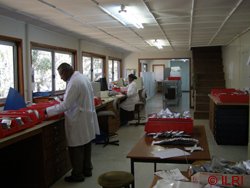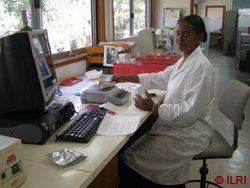Safety duplication of forage grass genetic resources
Contributors to this page: ILRI, Addis Ababa, Ethiopia (Jean Hanson); Bioversity International/ILRI, Addis Ababa, Ethiopia (Alexandra Jorge).
When should it be used
|
 Checking packets of seeds before dispatch for safety duplication (photo: ILRI) |
For all original seeds collected by the genebank or only held by the genebank (seeds which are duplicates from other collections can usually be retrieved from those collections and do not require safety duplication unless there is doubt about their security in the other collection). See also the general page on safety duplication procedures.
Sample specifications
Minimum sample size
- Minimum of 600 seeds (following FAO/IPGRI, 1994).
- 500 seeds are acceptable for the blackbox in Svalbard (more info on the Svalbard Vault can be found here and here).
- 1000 seeds are preferable.
Viability for storage
- More than 85% viability.
Moisture content
- At 3-7% (according to FAO/IPGRI, 1994).
Container specifications
 Packing seeds for safety duplication (photo: ILRI) |
Seed packaging method
- Laminated aluminium foil (packets are moisture proof and very practical, making good use of space).
- Use of vacuum for packing is optional.
- Packing is best carried out in an air-conditioned room with controlled humidity as soon as possible after drying (rapid packing in a dry environment prevents reabsorption of moisture by the seeds during packing).
Specifications of packaging material
- Minimum quality: outer polyester of 12 µm thickness, middle aluminium layer of 9 µm thickness and inner polythene layer of 55 µm (this thickness is impermeable, sufficiently flexible for handling and strong enough for forage grass seeds, which are usually smooth).
Storage specifications
|
|
Assigning location codes to boxes
- Boxes are numbered and lists of seeds per box should be maintained in a database (use of internal partitions increases weight and costs and in most cases entire boxes are returned to the owner).
Storage conditions
- Long-term storage (long-term storage is needed to ensure the longevity of seeds in safety duplication and the costs of preparing and shipping safety duplicates is not economic if storage is for short periods).
Shipping method
- Courier or air freight or any rapid method (method should avoid heating and delays in transport).
Legal arrangements
Common CGIAR agreements should be used:
- Standard agreement.
- Special agreement for Svalbard.
- Phytosanitary certificate.
- Certificate of origin.
- Certificate of no-commercial value.
- Electronic and hard copy of associated passport information; GMO-free certificate (if required).
Recording information during safety duplication
For large genebanks with active, base and safety duplication strategies, the following alternative is recommended (ICARDA model):
- Flag of safety duplicated (Y/N).
- Number of seeds.
- Weight of seeds.
- Year of production of seeds.
- Year of safety duplication.
- Name of institute holding the safety duplication.
- Box label where the sample is placed.
- Common steps (regardless of conservation strategy).
References and further reading
FAO/IPGRI. 1994. Genebank standards. Food and Agriculture Organization of the United Nations, Rome and International Plant Genetic Resources Institute, Rome. Available in English, Spanish, French and Arabic .
Nordgen. 2008. Agreement between (depositor) and the Royal Norwegian Ministry of Agriculture and Food concerning the deposit of seeds in the Svalbard Global Seed Vault. [online] The Svalbard Gloal Seed Vault, The Nordic Genetic Resource Centre, Alnarp, Sweden. Available from: http://www.nordgen.org/sgsv/scope/sgsv/files/SGSV_Deposit_Agreement.pdf. Date accessed: 23 March 2010.
Comments
- No comments found


Leave your comments
Post comment as a guest